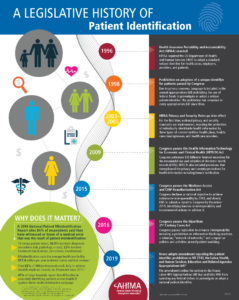WHAT IS PATIENT IDENTIFICATION?

Patient identification is the process of “correctly matching a patient to appropriately intended interventions and communicating information about the patient’s identity accurately and reliably throughout the continuum of care.” Patient identification encompasses not only physical identification of the patient, but technologies capable of improving the accuracy of patient identification as well. Different identification technological practices and operational processes are needed to meet the increasing and diverse demands for the access, exchange, and use of data by stakeholders to optimize accurate patient identification.
Today, lack of widespread operational principles as well as limitations in processes and technologies result in inaccurate patient identification. Accurate patient identification offers both improved patient safety and improved efficiency opportunities for healthcare providers—as well as enhanced interoperability.
IMPACT OF INACCURATE PATIENT IDENTIFICATION
Failure to accurately match patients to their health information raises the following patient safety, resource, and data sharing and interoperability concerns:
- Mismatch between patients and their clinical data is an increasingly serious patient safety issue. The 2016 National Patient Misidentification Report cites that 86 percent of respondents said they have witnessed or know of a medical error that was the result of patient misidentification.
- Patient misidentification often begins at registration and can generate a cascade of issues, including wrong-site surgery, delayed or lost diagnoses, duplicative testing, and wrong patient orders. At one hospital, 25 percent of clinicians surveyed indicated that the duplicate record rate was affecting the quality of care their patients received, and 30 percent of clinicians also reported reordering of tests due to lack of access to previous records.
- Absence of a consistent approach to accurately identifying patients has resulted in significant costs to hospitals, health systems, physician practices, and long-term/post-acute care facilities. On average, 35 percent of all denied claims result directly from inaccurate patient identification or inaccurate/incomplete patient information, costing the average healthcare facility $1.2M per year. Another survey indicates that 33 percent of all denied claims result from patient identification, costing the US healthcare system over $6 billion annually.
- Patient misidentification also raises data sharing and interoperability concerns. A 2017 American Hospital Association study indicates that 45 percent of large hospitals reported that difficulties in accurately identifying patients across health information technology systems limits health information exchange.
ACTION IN CONGRESS
Long-standing federal statutory language has hampered the ability of the US Department of Health and Human Services (HHS) to advance a nationwide patient identification strategy.
In 1996, Congress enacted the Health Insurance Portability and Accountability Act (HIPAA), which called for the creation of a unique patient identifier (UPI) to accurately identify patients. However, due to privacy and security concerns, Congress has included language in every spending bill since 1999 prohibiting HHS from spending any federal dollars to promulgate or adopt a national UPI.
Today, sustained and narrow interpretation of the language creates a barrier to public-private sector collaboration in advancing a nationwide patient identification strategy including but not limited to the adoption of a UPI.

